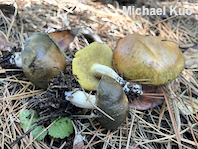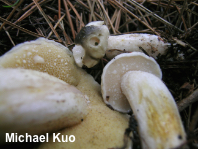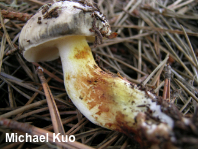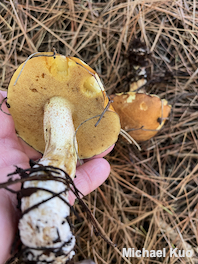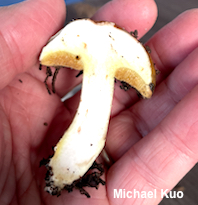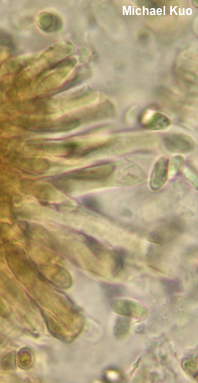| Major Groups > Boletes > Suillus > Suillus pungens |

|
[ Basidiomycota > Boletales > Suillaceae > Suillus . . . ] Suillus pungens by Michael Kuo, 21 January 2024 Suillus pungens is a Bay Area bolete, associated with Monterey pine and bishop pine. Look for it in late fall and winter after rains; it is a common mushroom in both urban and woodland areas. This species has a bewildering array of cap colors—often starting off whitish, then going through stages of gray and olive, and finishing off with shades of brown and yellow—so it may be best to focus on other features for identification. The young pore surface usually features droplets of milky liquid, and the stem features brown to reddish brown glandular dots. There is no partial veil, but the young cap margin is often whitish and soft, with a thin, sterile, overhanging portion. The epithet pungens refers to the odor and taste of this mushroom, which the original authors of the species (Thiers & Smith 1964) thought of as "unpleasant" and "not easily overlooked." However, the odor and taste are not always unpleasant, in my collections, which have been strongly fragrant. Description: Ecology: Mycorrhizal with 2- and 3-needle pines—primarily with Monterey pine and bishop pine; growing alone, scattered, or gregariously; late fall and winter; originally described from San Francisco (Thiers & Smith 1964); distributed in the Bay Area of California; also reported (perhaps erroneously) from Oceania. The described and illustrated collections are from California. Cap: 3–8 cm across; convex when young, becoming broadly convex; sticky when fresh; shiny when dry; bald; when very young whitish or whitish mottled with gray, but soon becoming gray to dark gray, then gray-brown to yellow-brown; when very young with a soft, whitish margin that sometimes exceeds the pore surface by 1–2 mm. Pore Surface: Pale yellow to creamy when young, exuding milky droplets of liquid when very young and fresh; becoming yellow to golden yellow with age; not bruising; with 1–2 pores per mm; pores not radially arranged; tubes up to about 1 cm deep. Stem: 3–8 cm long; 1–2 cm thick; more or less equal; whitish, sometimes with yellow and/or reddish brown discolorations; by maturity with brown glandular dots; basal mycelium white. Flesh: White to pale yellow in cap; yellow in stem; not staining on exposure. Odor and Taste: Odor strong, fragrant (see comments above); taste similar. Chemical Reactions: Ammonia purple-red on cap surface; salmon on pore surface; pinkish purple on flesh. KOH purple on cap surface; pink on flesh. Iron salts negative to grayish cap surface and on flesh. Microscopic Features: Spores 7–10 x 2–3 µm; boletoid-fusiform; smooth; yellowish in KOH. Basidia 19–25 x 4–5 µm; subclavate; 4-sterigmate. Cystidia in gelatinized bundles, often obscured by pigment globules; 30–50 x 4–8 µm; cylindric to clavate; thin-walled; smooth; brown in KOH. Pileipellis an ixocutis of elements 2–5 µm wide, smooth, hyaline to golden brown in KOH. REFERENCES: H. D. Thiers & A. H. Smith, 1964. (Smith & Thiers, 1964; Smith, 1975; Smith, Smith & Weber, 1981; Arora, 1986; Lincoff, 1992; Both, 1993; Bonello et al., 1998; Bessette, Roody & Bessette, 2000; Bruns et al., 2002; Bruns et al., 2002B; Kuo, 2007; Bruns et al., 2010; Klofac, 2013; Desjardin, Wood & Stevens, 2015; Nguyen et al., 2016; Siegel & Schwarz, 2016.) Herb. Kuo 01170503, 01112401. This site contains no information about the edibility or toxicity of mushrooms. |
© MushroomExpert.Com |
|
Cite this page as: Kuo, M. (2024, January). Suillus pungens. Retrieved from the MushroomExpert.Com Web site: http://www.mushroomexpert.com/suillus_pungens.html |
